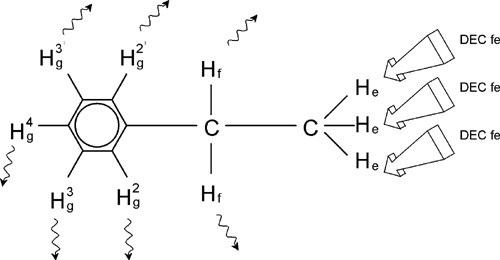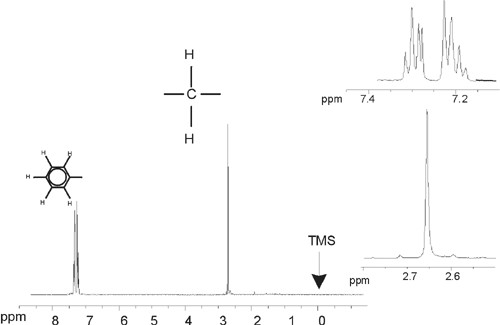Decoupling
The effect of spin-spin coupling can be removed by a technique called "decoupling“. The effect of decoupling is to mask the presence of a particular proton group, e.g. the He protons in the Ethylbenzene figure. A spectrum is acquired as if the He protons were absent! This is achieved by transmitting a decoupling pulse sequence at the He resonance frequency fe and thereby permanently changing the spin orientation of these protons. For the spectrum illustrated in the Ethylbenzene Spectrum figure the decoupling frequency would be 1.25 ppm above the TMS peak.
Decoupling pulses tend to be longer and of lower power than excitation pulses. The Decoupling Experiment figure below is a representation of a decoupling experiment, while the Ethylbenzene Spectrum with Homodecoupling figure shows the decoupled spectrum. The CH2 quartet has now become a singlet. Spectroscopists speak of the quartet collapsing to a singlet. Furthermore, the area under the singlet should be equal to that of the original quartet (compare the relative heights of the CH2 and benzene ring peaks in the two figures). The signal from the CH3 group at 1.25 ppm is missing from the decoupled spectrum, because the decoupling pulses effectively removes the effects of the presence of the CH3 protons.
Decoupling Experiment
Ethylbenzene Spectrum with Homodecoupling
The experiment described above is an example of homodecoupling in that the same isotope, namely 1H, is observed and decoupled. Heterodecoupling is where the isotope to be observed is different to that which is decoupled. In the chapter 13C Spectrum with Proton Decoupling of this manual you will perform a heterodecoupling experiment where you observe 13C and decouple 1H. AVANCE with SGU spectrometers have the ability to perform very complicated types of experiments depending upon the number of channels installed. A four channel spectrometer can be used to observe one nucleus and decouple three other nuclei. With up to eight independent channels the possible range of experiments is quite amazing. The user should be aware that currently the limiting factor is not in the generation of RF excitation and decoupling pulses but in transmitting these pulses to the sample via the probes and to some extent the preamplifiers. The signal routing of the experiment to be carried out is set up using the "edasp“ menu. More details can be found in the manual “Acquisition Commands and Parameters” (P/N H9775SA3).



